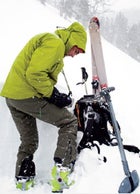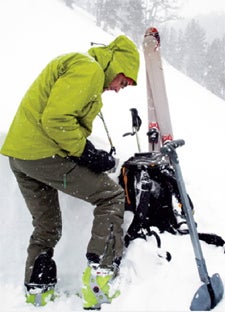Chabot is the director of the Gallatin National Forest Avalanche Center. He’s spent some 700 days in the backcountry studying the snowpack over the past 15 years.
Avalanche Safety
 Backcountry skiing
Backcountry skiing1. PREPARE: You need a buddy, a beacon (worn over your midlayer, not in your pack), a shovel, a probe. And pack a puffy jacket and a fire starter.
2. PRACTICE: Before heading out, have your buddy put his beacon inside a pack and bury it (at least three feet down), pinpoint its location with your transceiver and probe, then start digging. Another option is to head to one of 37 U.S. resorts that have beacon-training parks. If you haven’t gotten professional training yet, take an avalanche-safety course. [Locations of courses and beacon-training parks can be found at .]
3. PAY ATTENTION: Avalanche advisories () are generalized, and wind, temperature change, and snowfall can alter snowpack stability within hours. Look for recent avalanche activity, collapsing or cracking snow, and other warnings. If you’re skiing along flat terrain and the snow makes a whumph sound, Mother Nature just told you to go home.
4. WORK TOGETHER: Travel one at a time on 25-degree or steeper slopes, and leapfrog down mountainsides so you keep each other within sight. Don’t underestimate small slopes; they can slide. Make sure everyone knows the slope’s escape routes. Wait for each other out of a potential slide’s pathway.
5. MOVE FAST: If an avalanche strikes, try to ski out of its way. If it hits you, fight to get one hand out of the snow and wave your other hand in front of your face to create an air pocket. If your buddy gets hit, note where he disappears and start searching below that spot. Look for obvious clues: gloves or a pack. He has a 92 percent chance of survival if he is uninjured and you rescue him within 15 minutes. The clock is ticking.


